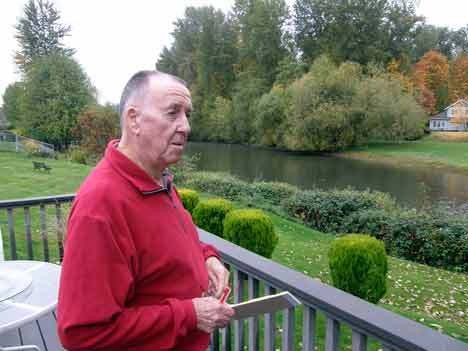Nine years ago, Jim and Billie Fugate moved from their home of 29 years on Lea Hill to a house on Pike Street just where it curves into 12th Street.
Their backyard overlooks a pretty bend of the Green River north of Porter Bridge, and from their deck the couple can watch the river flow past, marvel at the leaping salmon and count their luck.
Fugate, a former superintendent of the Auburn School District, never tires of looking.
“When the fish first started coming up a month ago, you couldn’t see the bottom of the river,” said Fugate.
The river is a wonderful part of the Fugates’ lives. But evidence of its fiercer side is there, too.
“See that sand bar up in the grass there?” said Fugate, pointing to the opposite bank of the river. “That sucker is about four feet deep, and it wasn’t there a year ago at this time.”
Savvy to the flood danger posed by the compromised holding capacity of the Howard Hanson Dam this season, Fugate wants to protect his riverbank home from possible damage this fall and winter.
As the long list of crossed-out to-dos on his yellow pad attests, he’s been extremely industrious about it. And what he couldn’t do for himself, he hired others to do for him.
There was the surveyor he brought out to complete work necessary to make him eligible for flood insurance.
“I was the only one along this street who did that, and I still don’t understand why. The insurance only runs about $350 a year, and it’s $250,000 on the house and $100,000 on the contents,” Fugate said.
Fugate brought another fellow to the house to check the crawl space, to make sure the Visqueen plastic sheeting was in good shape and that his duct work and insulation were up and where they were supposed to be.
“If water gets in there, it may be vulnerable,” said Fugate. “Most crawl spaces are about 3 feet high. If your duct work is down too low or the insulation is loose, you’re going to be replacing that.”
He designed covers for his air vents and a friend cut them for him.
“I put this handle on it to make it easier to put on and pull out,” Fugate said, pulling one off the work bench. “See that, it snaps right into there.”
He will secure the cover to his air vents with sealant.
“It’s a common-sense thing. I show [the covers] to my neighbors, and they say ‘That’s a good idea.’ I’ve got a buddy next door, an old bachelor, and I try get him do him do everything I’m doing because he’s as vulnerable as I am,” Fugate said.
He brought someone out from J and M Construction to install a backflow valve on his sewer pipe.
“The city has made it so you don’t even have to get a permit to put it in. It costs about $37. As long as the flow is going out, the flapper stays open, but it shuts on anything that tries to come back up. He put it in for $87. He’s a handy guy who does all kinds of things. He put that sucker in there in 45 minutes.”
Fugate lifted a plastic sheet in his garage revealing a pallet of sandbags.
“I’ve got 100 sandbags there. I got them from the Bag Lady in Puyallup. They delivered the pallet using a forklift. The guy said to be sure to cover them because the material is very vulnerable to ultraviolet rays. They should last five years at a minimum. Over here I’ve got some different shapes, some 60-pound and some 40-pound bags.”
He’ll put them where they’ll do the most good.
“They tell us we are going to be as vulnerable from the street as from the river. This is the crawl space entry, so those bigger bags I will probably use them around here. Another thing is I had the washer and drier vented out there. I had a guy out and he put the vent on top, and there’s flexible tubing so it vents out there, and I just duct tape over it.”
Fugate even brought professionals in to mark his irrigation heads with little red flags.
“That’s so when the people scheduled to come in to shore up the yard with sandbags arrive, they won’t have to guess where the heads are,” Fugate said.
About a quarter mile away, Riverview Drive resident Len Elliot is also preparing his home.
“I’ve got things at the lower level of my house that I will be moving. I haven’t got a whole lot of room in my house. I’m sitting at a higher elevation than other folks, but it’s still going to come in my back yard,” said Elliot.
“Water coming by at 12,000 cubic feet per second is only a foot or two below the top of the [Dykstra] levee, and they are talking about 17,000 cubic feet per second, which puts it over the top as far as I am concerned. I bought flood insurance, so I will protect myself that way, but I don’t know what else to do. I’m thinking sandbags. I’m concerned. I have talked to my neighbors, and they have bought flood insurance. The corps has said they are working on this, but how complex can it be?”
Talk to us
Please share your story tips by emailing editor@kentreporter.com.
To share your opinion for publication, submit a letter through our website https://www.kentreporter.com/submit-letter/. Include your name, address and daytime phone number. (We’ll only publish your name and hometown.) Please keep letters to 300 words or less.

